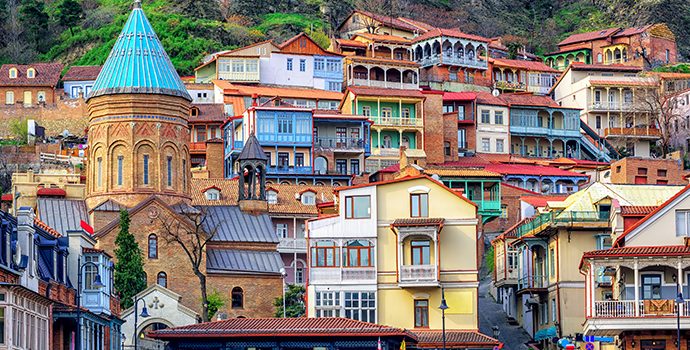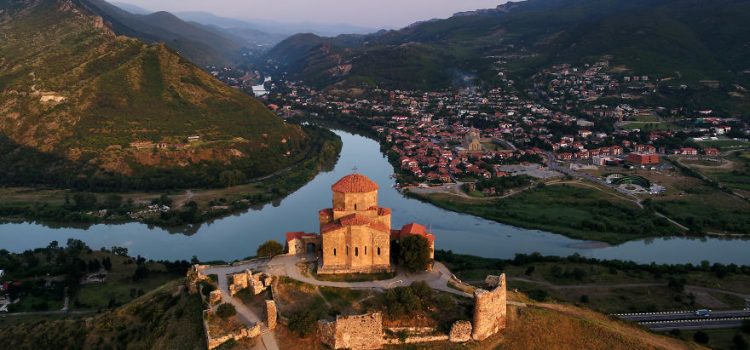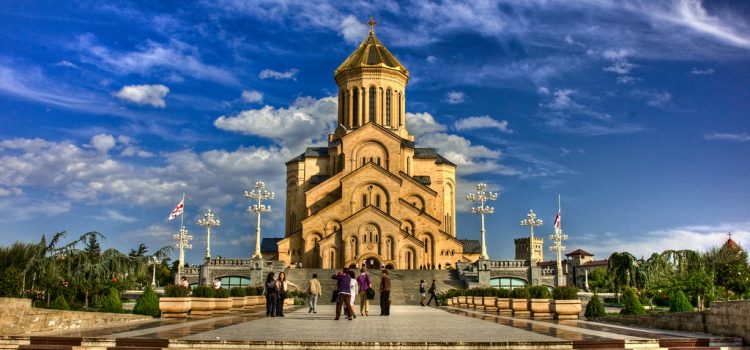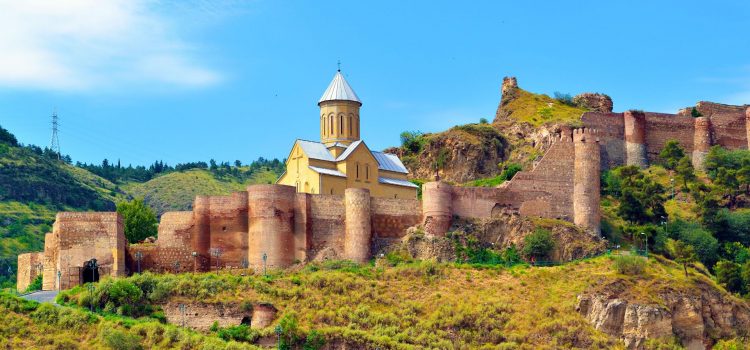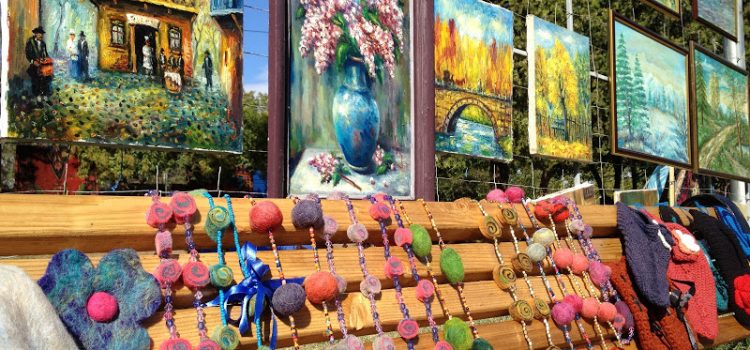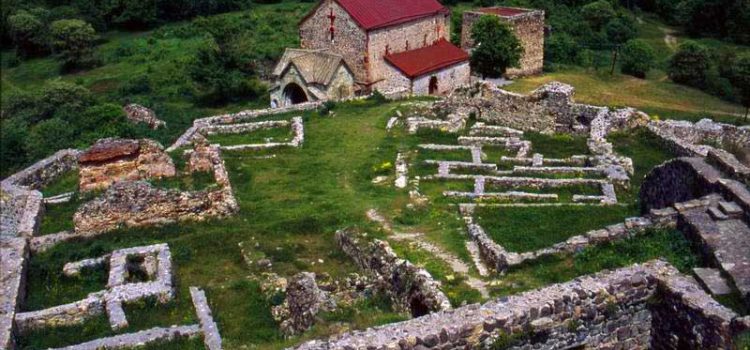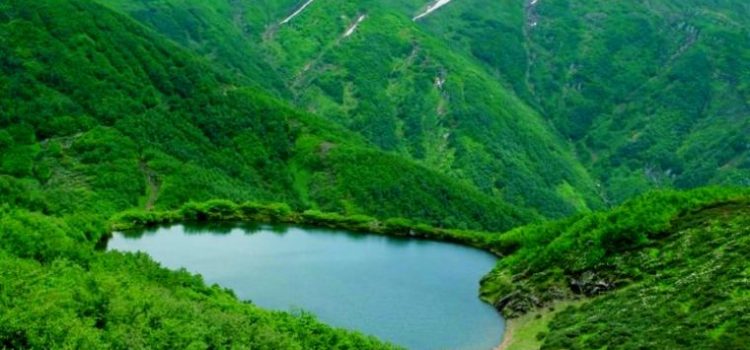Bakuriani – Skiing resort in Georgia
Bakuriani is known for days with long sunshine, for 2052 hours a year and long snowy winter from December to March. Winters are cold and experience sufficient snowfall while summers are long. Average January temperature is – 7 and in August +15 degrees by Celsius. Average snow cover makes 64 cm.
Cristal clean air of high mountains, predominantly coniferous (mainly made up of spruce) forest filled with the perfume of beech trees, Kokhtagora, Kokhtagora II and views of mountains of Tskhratskaro attract attention of visitors during all seasons of the year.
No wonder that Bakuriani is one of the most famous mountain resorts among Georgian international ski resorts. Its climate and relief is ideal for the development of varieties of winter sports. First skiers were fixed here in 1932.
During winter seasons families with kids and fans of skiing adults equally enjoy staying here. Cable ways can be found in several places, on the Kokhtagora mount (1.3 km), Kokhtagora II, Sakhvelo mount (3.8km), under 90 and 25 m. ski jumps and there are also places for tobogganing in the park. The Kokhtagora along with other ski runs is one of the best difficult skiing runs for professional skiers.
Bakuriani is a mountain-climate resort with its main curative factors: mountain air, long time sunshine, high activity of ultraviolet rays. One can be cured here from lymphadenitis, chronic non-tuberculosis illnesses of respiratory tract and anemia. One can visit High-Mountain Botanical Gardens, the branch of the Tbilisi Botanical Institute (founded in 1919) with the best collection of alpine flora in Europe.
5 Things Not to Miss:
1. Snowmobile sightseeing
2. Sledges and horse riding
3. Parks for kids
4. Panoramic views
5. Après ski
Source: Skigeorgia.ge
10 things to do in Tbilisi
What is it about Georgia lately? The country (not the US state) seems primed to be one of the hottest tourist destinations for 2017, as travellers are freshly obsessed with the fashion, the mountain trekking, the architecture, and the good eats. The best news for those travelling from the UK? Georgian Airways launched direct flights from Gatwick to Tbilisi over the weekend; next month, Wizz Air will start a route to Kutaisi from Luton. Want to see what all the fuss is about? Here are our top 10 tips for what to do in Tbilisi.
Browse Soviet relics
From 1921 to 1991 Georgia was part of the Soviet Union. This history is evident everywhere, but most in your face while walking through the Dry Bridge Flea Market near Dedaena Park. Locals who lived the bulk of their lives under Soviet rule spread blankets on the ground and lay out goods they’ve saved from the scrap heap. The range of items is boggling; it’s priceless antiques next to plumbing fixtures, next to tarnished military medals and handmade crafts. Be prepared to bargain, and to receive a history lesson with each purchase.
Learn the etiquette of “khinkali” dumplings
Georgian dumplings are plump, round pouches filled with minced meat, chopped onion and spices. Pinched closed, you then flip the dumpling over and gingerly bite into its skin, sucking out the hot soup inside before going in for whole bites. Don’t eat the pinched bit; it’s not always cooked through and is used for staff to later count how many were eaten. Khinkali are omnipresent on menus in Tbilisi, but head to Barbarestan on Aghmashenebeli Avenue to try them alongside other Georgian dishes, their recipes straight from Barbare Jorjadze, a 19th-century princess and renowned cook who is generally accepted to have been Georgia’s first feminist.
Strip down and suds up
The ancient district of Abanotubani in Tbilisi’s old quarter is home to several equally ancient sulphur bathhouses. Head underground through brick entrances to pay an attendant for towel and sandal rental, and your choice of communal shower (separate for male and female) or private room with soaking tubs. Add on an exfoliating scrub-down and soapy foam massage for a few pounds more, but be warned that complete nudity is the rule. At the simply named Bathhouse Number 5, exquisite mosaics decorate the domed rooms, making up for the faintly eggy smell of the sulphur water.
Party at Fabrika
An old sewing factory turned hostel sounds like a stereotypical hipster hangout, and that’s totally true in Tbilisi. Fabrika offers communal, hostel-style rooms from as low as £10 per person, and private ensuite rooms for two are from £38 per night, but guests should be warned that the party in the public areas often lasts well into the night. The lobby bar Cocktails and Dreams, the courtyard strung with fairy lights, and the co-working spaces and artisan shops that make up the complex draw locals as well as visitors; you’ll make friends fast here.
Take in some culture
Tbilisi is no backwater destination; the spectacular Zurab Tsereteli Museum of Modern Art plays host to a biannual Fashion Week, the stunning architecture of the modern Peace Bridge lights up the riverfront at night, and the oddity of the 2011-constructed “Leaning Tower of Tbilisi” (aka the Gabriadze Clock) provides plenty of opportunities for Instagramming.
Eat a cheese-stuffed bread boat
Better known as “Acharuli Khachapuri”, this traditional Georgian comfort food is a gluten-free traveller’s nightmare, but heaven to most. The boat-shaped flatbread arrives fresh from the wood oven to the table, its centre bubbling with melted cheese, a runny egg, and a generous pat of butter. Even a small order is enough for two people, especially with a side of khinkali.
Yes, Georgian wine is fabulous. Red or white, dry or sweet, it’s all extraordinarily drinkable thanks to the fertile environment of the lower Caucasus, one of the most ancient viticulture regions in the world. But branch out beyond the wine for chacha (ჭაჭა), which is no dance in Georgia. Chacha technically refers to any fruit-based liquor, but it’s come to be most synonymous with grape brandy, produced from the leftovers during winemaking. It’s clear and strong, and most similar to Italian grappa. Stop into the parlour-style Books Cafe on Tsinamdzghvrishvili Street (yes, Georgian street names are epic) for a thimble full of chacha, a game of backgammon, and a browse of their used books for sale.
For something a little less strong, hit up a Georgian soda fountain for “Lagidze waters,” cool and sparkling concoctions of flavoured syrup mixed with mineral water. Invented by pharmacist apprentice Mitrofan Lagidze in the late 1800s, the drinks are cheap, fast, and refreshing. The most popular varieties of lemon, grape, cherry, and even chocolate, are poured and mixed from traditional dispensers at places like Acharulebi Lagidzeze and the aptly named Lagidze Water at Sameba Cathedral. Point to the bright green syrup to try Tarkhun, or tarragon soda, a flavour embraced by the Soviets and now produced and available bottled in supermarkets as “Тархун.”
Get high
Tbilisi sits in a valley, cut through by the Mtkvari River and backed by small mountains. Heading up Mount Mtatsminda to reach a small amusement park and the best view over the city is easy via modern funicular. There’s also the option to visit the Narikala Fortress via cable car from Rike Park, which comes with the bonus of gliding right over the twisting streets of Tbilisi’s old quarter before arriving to the medieval ramparts of the fort.
Make a salad
According to Megan Starr, a travel blogger who regularly visits countries of the former USSR, Tbilisi is the perfect destination for salad lovers. If there’s one dish ideal for summer, it’s the simple and filling Georgian Salad. Quarters of ripe, juicy tomatoes fill a bowl with slices of onion, cucumber and green pepper. It’s finished with a palmful of walnuts, a dusting of pepper, and a drizzle of olive oil. Get it at Linville, a cosy and antique-filled first-floor cafe near Freedom Square, where the salad is terrifically refreshing on a humid day, and even better with a glass of crisp white Georgian wine.
Get out of town
Technically this list is what to do in Tbilisi and can be rushed into a long weekend. If you have more time, use the trip as a two-for-one, adding exploration of Kutaisi, Kazbegi or Batumi to your plans. Kutaisi is a pedestrian-friendly city of streets lined with gardens, theatres, and several medieval church and monastery UNESCO World Heritage sites. The frontier mountain town of Kazbegi, also called Stepantsminda, is for hikers and, in the winter, for skiers. The Georgia-based luxe hotel group Rooms Hotels recently opened a “retro-Soviet meets industrial chic” property in the town.
Source: Independent.co.uk
Jvari monastery in old capital – Mtskheta
According to local history, in the early fourth century a wooden cross was erected over a pagan sanctuary on a rocky mountaintop overlooking Mtskehta, the former capital of the Georgian Kingdom of Kartli-Iberia. The construction of the cross symbolized the fall of paganism and rise of Christianity in Georgia. In 545, a cruciform church, known as the Small Church of Jvari, was built just north of the cross. Between 586 and 605, a larger church was constructed directly above the site of the wooden cross, the base of which is still visible inside the church. Exceptional relief sculptures decorate the exterior façades of the Great Church. Their fine proportions and remarkable technique distinguished the sculptures from the earlier bas-relief carving common in the region. In 2004, the monastery was placed on the UNESCO World Heritage List as part of the Historical Monuments of Mtskheta and was added to the UNESCO List of World Heritage in Danger in 2009.
2006 World Monuments Watch
Greatly deteriorated from centuries of water damage, violent regional conflicts, and inadequate maintenance, Jvari Monastery was included on the 2006 World Monuments Watch. Missing its roof, the interior mosaics and frescoes of the small church have been largely destroyed by the elements. Heavy pressure from the upper walls and dome threaten the Great Church’s structural stability, while acid rain and strong winds had eroded the exterior bas-reliefs. In the late 1980s, restoration works on the small church were halted for fear of endangering the authenticity
of the church. Later restorations in 2002 were suspended for the same reason, having lost most of the original building records in a fire in 1991. In 2006, WMF supported the thorough documentation of the buildings and a study of the original construction and consequent interventions. The project allowed for the development of conservation guidelines for the monastery. A joint stone conservation and training project by Ministry of Culture and ICCROM established in 2005 worked on the conservation of the Great Church’s bas-reliefs, completed in October 2011. A proposal for the conservation of the small church and for the rehabilitation of visitor infrastructure was then submitted to the World Heritage Center.
Located at the precipice of a vertical cliff, Jvari Monastery is a remarkable sacred landmark visible from the ancient city Mtskheta. The building techniques and high standards of engineering, as well as the diverse decorative program, of the landscaped monastery exemplify exceptional centuries-old Georgian building practices alongside a wide range of Eastern and Western aesthetic traditions. Although the tetraconch architectural type did not originate in Georgia, it underwent a unique and complex development in the country. The Great Church represents the peak of this architectural typology and serves as a model for numerous other churches. Jvari has been an important pilgrimage site since its founding and is considered one of the most sacred places in all of Caucasus. The Great Church is still used today for major celebrations.
Source: www.wmf.org
Holy Trinity Cathedral of Tbilisi
The Holy Trinity Cathedral of Tbilisi commonly known as Sameba is the main cathedral of the Georgian orthodox church, located in Tbilisi, the capital of Georgia. Constructed between 1995 and 2004, it is the third tallest Eastern Orthodox cathedral in the world and one of the largest religious building in the world by total area. Sameba is a synthesis of traditional styles dominating the Georgian church architecture at various stages in history and has some Byzantine undertones.
The idea to build a new cathedral to commemorate 1,500 years of autocephaly of the Georgian Orthodox Church and 2,000 years from the birth of Jesus merged as early as 1989, a crucial year for the national awakening of the then Soviet republic of Georgia. In May 1989, the Georgian Orthodox Patriarchate and the authorities of Tbilisi announced an international contest for the “Holy Trinity Cathedral” project. No winner was chosen at the first round of the contest when more than a hundred projects were submitted. Finally the design by architect Archil Mindiashvili won. The subsequent turbulent years of civil unrest in Georgia deferred this grandiose plan for six years, and it was not until November 23, 1995, that the foundation of the new cathedral was laid.
The construction of the church was proclaimed as a “symbol of the Georgian national and spiritual revival” and was sponsored mostly by anonymous donations from several businessmen and common citizens. On November 23, 2004, on St. George’s Day, the cathedral was consecrated by Catholicos Patriarch of Georgia Ilia || and high-ranking representatives of fellow Orthodox Churches of the world. The ceremony was also attended by leaders of other religious and confessional communities in Georgia as well as by political leaders.
The Sameba Cathedral is erected on the Elia Hill, which rises above the left bank of the Mtkvari river in the historic neighborhood of Avlabari in Old Tbilisi.
Source: Wikipedia.com
Narikala Fortess in old Tbilisi
Narikala fortess- also called the Mother Fortress of Tbilisi, Narikala is an ancient symbol of Tbilisi’s defence. The fortress was established in the 4th century, around the period when the city itself was founded. It was then known as Shuris-tsikhe (Invidious Fort). The name Narikala is said to derive from a Persian word for citadel, but another theory says was the name that Mongols used, meaning “little fortress”. It was expanded considerably by the Arabs during the 7th and 8th centuries. The Arabs built the Emir’s palace within its walls. King David further extended the Builder the fortress in th 11th century. Most of the existing fortifications date from the 16th and 17th centuries. In 1827 it was damaged by an earthquake and was not resorted. St. Nikolos church, inside the fortress walls, dates from the 12th century. It was renovated in 1996. Narikala offers you some of the best panoramas of the city.
We’d also advise you to take a walk along the Narikala Tourist route, a 1500 metre trail that runs from the top of the ridge near the Mother Georgia statue, around the fortress and down into Old Town to near the entrance to the Botanical Gardens. It offers stunning views at every turn and is a particular delight at night when the city lights shine below.
source: www.inyourpocket.com
Dry Bridge Flea Market – Best Place For Unique Souvenir Shopping In Tbilisi
Located in Tbilisi’s historic old town, 20 minutes walk from Freedom Square, Dry Market is the place, where you can buy literally every souvenir you ever dreamed of.
Even more, alongside traditional, typical tourist trinkets you can encounter old military medals from WWII, old enamel, Soviet kitsch, handmade jewelry (sometimes very eye-catching and exquisite pieces), vintage cameras and many other stuff without much fuss.
Here You can find original eastern European, Soviet, Georgian and even Armenian or Azerbaijani souvenirs.
Many pins and badges are waiting for you to choose and take home.
There are many oil paintings and watercolors, usually full of amazing, bright colors and cheerful spirit.
You may spend several hours just wandering and exploring from one to another, because you will never know, what another surprise is waiting for you at the next one.
You can see old Samovars, cameras, books, family photos, postcards, eyeglasses, playing cards and many other.
Also, there are sometimes absolutely unexpected things.
So, next time in Tbilisi, you know where to go for shopping
Source: Georgia.travel; Megapass
Taste Of Georgia: Ajara, Samegrelo, Svaneti
Going to Georgia, travelers usually prepare themselves to enjoy khachapuri, lobio, khinkali and, of course, a variety of meat barbecues, which are called “mtsvadi” in Georgian. Advanced experts in Georgian cuisine leave some free space in the stomach for pkhali, eggplants in walnut sauce, chakhokhbili and kharcho. However, our compact country has such a rich variety of regional dishes, that even if you decide to try one new for breakfast, lunch and dinner, you will need more than several weeks to explore the whole treasury.
Let’s take a little journey through the regions of Georgia and see what they can offer!
Starting with the West Coast… Well, Ajarian cuisine can really be described as “cheese rolling in butter”. Locals prepare very tasty and high-calorie meals. One of them is sinori, gentle rolls made of thin dough baked with matsoni/yoghurt and butter. Sinori can be eaten for breakfast – especially if you days is promising to be busy – or for a heavy family dinner.
Another calorie bomb from Ajara is called borano. It is made of Adjarian cheese melted in butter. Be prepared: it will be difficult to leave the table after you are finished!
Samegrelo, another Western Black Sea region of Georgia, is famous for the fact that its inhabitants prefer very spicy food. Megrelian adjika sauce is so sharp that Chuck Norris himself would probably cry, having tried it. If we talk about dishes, the most significant for the region are gebzhalia and elarji. Elarji is polenta brewed from corn flour with suluguni cheese inside. This heavy delicious dish should served hot!
Gebzhalia is a starter, delicate rolls with fresh cheese and mint in matsoni/yogurt sauce. It just melts inside your mouth, and is contrasting to those extremely spicy dishes and sauces that are served after.
From Samegrelo it is logical to climb higher into the mountains – to Upper Svaneti. This fabulously beautiful region with harsh living conditions is famous first of all for its special seasoning – Svan salt. Common salt is mixed with local spices in a special wooden mortar, and thus turns into slightly moist flavorful spice that can be used with salads, as well as with meat and fish.
Typical Svanetian pastry is kubdari, a tortilla stuffed with meat. In such difficult living conditions as there, meat filling is an excellent source of calories, and tortilla format is a convenient option for takeaway eating. The shepherds take kubdari as they travel to pastures, and eat them during a long time there.
Another traditional Svan pastry is chishdvari (down the mountains, in the rest of Georgia it is called “chvishtari”). It is made from corn flour, and keeps a piece of suluguni cheese inside. Chishdvari is especially tasty, as it’s taken just from a pan, and you eat it looking at the highest peaks of Georgia – let’s say, Shkhara – and breathe fresh air at an altitude of over 2,000 meters.
The first part of our culinary journey through the regions of Georgia is about to end now. Nevertheless, there is still a lot of interesting stuff for you! Stay tuned with Georgia and Travel!
Source: Georgia.travel
Heritage Sites
Heritage Site
Cave Towns Among the few notable cave towns in the world, the Georgian ones are of very special interest. Uplistsikhe, David Gareji monastery, and the world-famous cave town of Vardzia are nominated for the UNESCO World Heritage list. Uplistsikhe, ‘the fortress of the Lord’, can be dated back to the early Iron Age, and is located on a high rocky escarpment overlooking the bank of the Mtkvari River. Cut from natural sandy stone, the 8 hectares of cave-town have survived millions of people, erosion, aging and even earthquakes, but it still remains a good example of the mixture of pagan & Christian architecture. David Gareji monastery was founded in the 6th century on the slopes of the Gareji hills by one of the thirteen Syrian Fathers, Father David (Garejeli). Those fathers were missionaries from Mesopotamia promoting and spreading Christianity, the respected founders of many monasteries and holy places around Georgia. The frescoes here are superb. Some of them date as far back as the 9th and 10th centuries. The Golden Age of Georgia is directly reflected in the incredible 11th – 13th century frescoes. The incredible cave town of Vardzia dates back to Queen Tamar’s reign, nearly a thousand years ago. Her father, King George III started the foundation of the complex, while Queen Tamar continued its construction. Many frescoes date back to the beginning of the XII century. The complex itself consists of small chapels, bell towers, secret tunnels, monks’ caves as well as a fully functioning monastery to this day. Set in the most serene and stunning countryside, its beautiful location captures your imagination and brings you back to the era of Queen Tamar’s reign. Bagrati Cathedral and Gelati Monastery(UNESCO WEB) The construction of Bagrati Cathedral, named after Bagrat III, the first king of united Georgia, started at the end of the 10th century and was completed in the early years of the 11th century. Although partly destroyed by the Turks in 1691, its ruins still lie in the centre of Kutaisi. The Gelati Monastery, whose main buildings were erected between the 12th and 17th centuries, is a well-preserved complex, with wonderful mosaics and wall paintings. The cathedral and monastery represent the flowering of medieval architecture in Georgia. Historical Monuments of Mtskheta(UNESCO WEB) The historic churches of Mtskheta, former capital of Georgia, are outstanding examples of medieval religious architecture in the Caucasus. They show the high artistic and cultural level attained by this ancient kingdom. Upper Svaneti(UNESCO WEB) Preserved by its long isolation, the Upper Svaneti region of the Caucasus is an exceptional example of mountain scenery with medieval-type villages and tower-houses. The village of Chazhashi still has more than 200 of these very unusual houses, which were used both as dwellings and as defence posts against the invaders who plagued the region.
Meet your hominid ancestors in Georgia
Over 500 Paleolithic sites have been discovered in Georgia, which is considered a crossroad of cultures due to its location in the South Caucusus. Dmanisi, southeast of the capital Tbilisi, is considered one of the most significant sites.
“Exactly twenty five years ago we found a human jaw in Dmanisi – this was big sensation. It was impossible to imagine that you could have 1.8 million year-old fossils out of Africa. Since this discovery we have discovered another fossil. Now we have five skulls, four with jaws, different anatomical elements as well as animal bones and stone tools. Now, we could say that we have the best collection in the world of the early Homo out of Africa,” explains David Lordkipanidze, general director of the Georgian National Museum,
The Dmanisi skull is the most complete ancient hominid skull found to date. Known as Skull 5, it was discovered alongside the remains of four other early human ancestors, animal fossils and stone tools – all believed to be from the same time period – which makes the find truly unique.
“It’s the first evidence of humans moving out of Africa – very simple stone tools, brains literally a third of size of modern humans, but nonetheless they were able to exist in an environment with large saber-tooth cats and hyenas and other dangerous animals. It’s quite incredible,” says Nicholas Toth, co-director of the Stone Age Institute in Indiana.
The finding has forced scientists to rethink the story of early human evolution, as it could mean that rather than several Homo species, only a single-species – able to cope with a variety of ecosystems – emerged from the African continent.
‘Stone Age Georgia’ runs at the Georgian National Museum until September 2017.
Source: Euronews.com
Mtirala: Georgian nature at its purest
It is pure, unblemished nature…
Yet the Mtirala National Park can be found just 40 kilometres from Batumi, the capital city of Georgia’s autonomous republic of Adjara.
“We’re lucky to have the sunshine: this Adjarian national park, Mtirala, is considered Georgia’s rainiest spot of land,” said Euronews reporter Denis Loctier, as he explored the region.
In this high humidity, the air is fresh and fragrant with blooming flowers and herbs.
It’s a protected site for the region’s flora and fauna, including rare and endangered endemic species.
“Mtirala translates as ‘a weeping mountain’. This place is often clouded in mist and drizzle. That’s where the name comes from,” explained park guide, Zia Kontselidze.
At 1,500 metres above sea level, Mtirala’s trails are perfect for hiking, bird watching and adventure tours.
Source: Euronews.com


